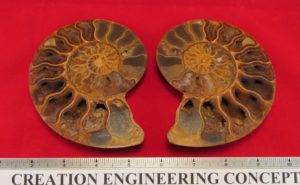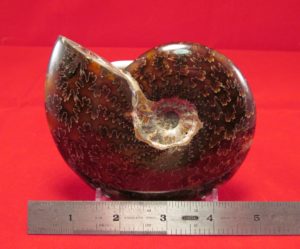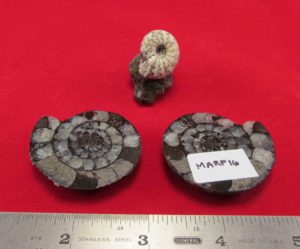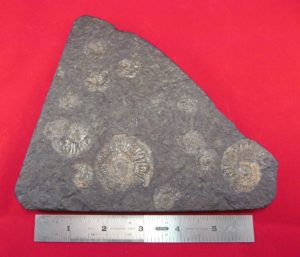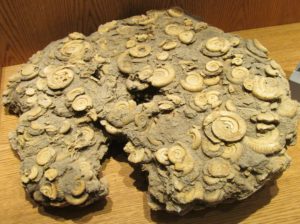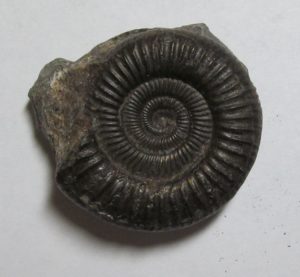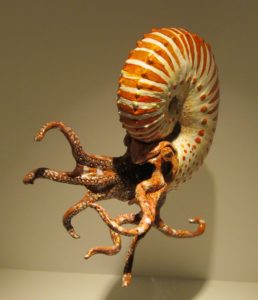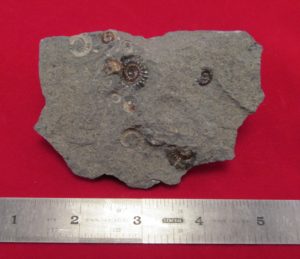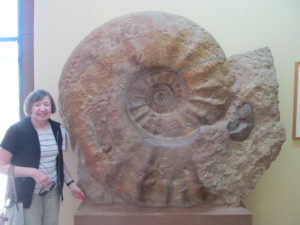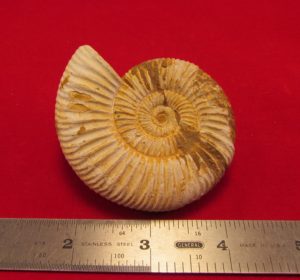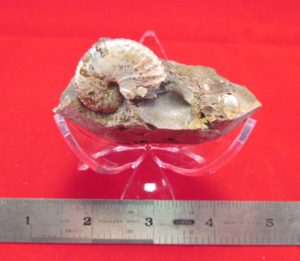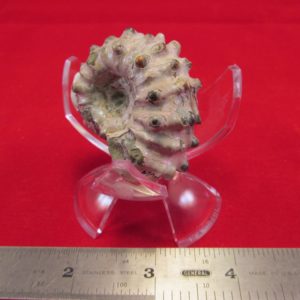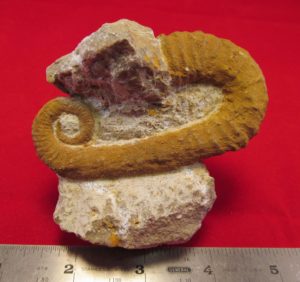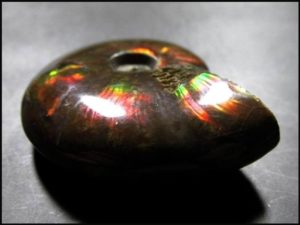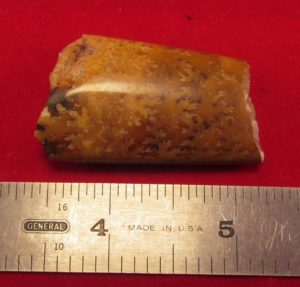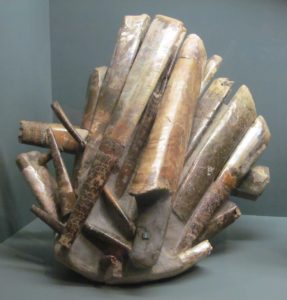All fossil images and descriptions ©2017 all rights reserved. Contact us for permission policy.
Ammonite Desmoceras
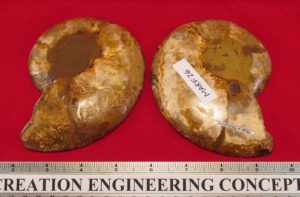 Description: Each half of the spiraling ammonite is 5 3/8″ wide X 4 1/4″ high X 11/16″ thick maximum. The largest chamber at the spiral end is 3/4″ wide X 1 5/8″ long. There are 50 countable septum-separated chambers in the fossil. All septae are curved to various shapes with none being straight. Calcite crystals are visible in all the of the chambers. The fossil is completely permineralized and sutures are visible on the left half of the lower image that shows the exterior of the ammonite. Matrix material has not been removed from either half at the exterior center of the ammonite. The siphuncle is located at the edge of the spiral unlike in the nautilus where it goes up the center. (The siphuncle is a thin-walled tubular extension of the mantle that passes from chamber to chamber and regulates the buoyancy of ammonites and nautiloids.)
Description: Each half of the spiraling ammonite is 5 3/8″ wide X 4 1/4″ high X 11/16″ thick maximum. The largest chamber at the spiral end is 3/4″ wide X 1 5/8″ long. There are 50 countable septum-separated chambers in the fossil. All septae are curved to various shapes with none being straight. Calcite crystals are visible in all the of the chambers. The fossil is completely permineralized and sutures are visible on the left half of the lower image that shows the exterior of the ammonite. Matrix material has not been removed from either half at the exterior center of the ammonite. The siphuncle is located at the edge of the spiral unlike in the nautilus where it goes up the center. (The siphuncle is a thin-walled tubular extension of the mantle that passes from chamber to chamber and regulates the buoyancy of ammonites and nautiloids.)
Location: From the island of Madagascar.
Interpretation: Fossil importers throughout the world love to sell these beautiful fossils from Madagascar that have been sliced in half and then polished. Many of the smaller specimens are made into earrings or pendants. Usually these ammonite fossils are identified with genus names Cleoniceras or Desmoceras.
Nearly all of the ammonite fossils from Madagascar have been somehow altered for added value because Madagascar export laws make it illegal to export unprocessed fossils. Ammonites have been found in locations throughout the world and often take on many beautiful minerals through the permineralization process. Ammonites are one of the fossils often used as “index” fossils by secularists to conform to their geologic timeline. In reality all of these fossils were rapidly buried sometime during the year-long worldwide Flood.
#MARF26
Ammonite Cleoniceras
Description: The Cleoniceras fossil ammonite is 4 1/2″ wide X 3 7/8″ high X 15/16″ thick and has had a large portion of the in-filled surface polished by island craftsmen. Complex suture lines are prominent over the entire surface.
Location: Madagascar.
Interpretation: “A suture line is the pattern made by the lobes and saddles of a single septum around its entire edge. Generally the suture line is simple for the first few septae, and becomes more complex with successive ones. Groups of closely related ammonite species often have similar suture lines, and so the suture line is useful in classifying ammonites.” (Monks, Neale & Palmer, Ammonites, Smithsonian Institution Press, 2002, p.153.)
The varying beautiful suture patterns on ammonites are best explained as ramifications of God’s artistic and engineering capabilities.
#MARF37
Ammonite Craspedites
Description: Upper specimen of Craspedites with sutures is 7/8″ across X 3/8″ thick maximum and is connected to a chunk of matrix 7/8″ X 7/8″ X 1 1/4″. The chambers on this specimen are preserved as grayish-white calcite crystals and the septa are preserved as black calcite. The cut and polished specimen below is 1 1/2″ in size and has a typical ammonite chamber and septa design.
Location: Upper specimen from the Volga River and the Ulyanovsk Region. Lower specimen is from Saratov, Russia.
Interpretation: The value of these specimens is to illustrate beauty and design; and the upper specimen helps in understanding the connection between the septa that separate the chambers and the suture marks left by their connection to the inside of the shell. This beauty and design is easier to understand as coming from the mind of God than from the random interaction of matter over deep time.
#MARF15 &16
Ammonite Dactylioceras -1
-2
-3
Description: In image -1 above there are at least twenty Dactylioceras ammonites of various sizes embedded in the matrix, many requiring magnification to properly study. The largest specimen is 1 1/2″ across and the triangle-shaped specimen is 5 3/4″ high X 7 1/4″ wide X 1/2″ thick.
In image -3 the Dactylioceras is 1 1/4″ wide X 1 3/8″ high X 3/8″ thick. The ammonite is embedded into a matrix on the back for a thickness of 5/8″. This fossil is pyritized.
Location: Slab from Holzmaden, Germany. Single ammonite in image -3 from New Yorkshire, England.
Interpretation: Images -1 and -2 are of what secular scientists describe as “mass mortality plates.” There are innumerable fossils jammed together and piled one on the other in these fossil jumbles. The interpretive plate at the Wyoming Dinosaur Center display in image -2 explained the Dactylioceras jumble as the result of a storm, but storms regularly happen today without the same result. These types of fossil graveyards match up nicely with the expectations of the conditions caused by the Genesis Flood.
Pyritized Dactylioceras fossils are best known from northern England. Many of the fossils from there have had snake heads carved into the openings so they can be sold to unsuspecting tourists as petrified coiled snakes. It has an evolute shell in which successive whorls slightly overlap. The variations in color and hardness of these fossils in the three figures above are due to the differences in the minerals that were adjacent to the ammonites when or after they were buried in the Flood.
#MARF11, 36
Ammonite Reconstruction
Description: This is a reconstruction of what a typical ammonite may have looked like when alive (at the Houston Museum of Natural Science).
Ammonite Promicroceras
Description: Six ammonites are visible in the sandstone matrix along with several casts of others. The largest ammonite is 9/16″ wide. The smallest ammonite is 1/4″ wide.
Location: Dorset, United Kingdom, Lyme Regis.
Interpretation: There are two different styles of ammonite in this small rock slab. The ribbed ammonites are identified as genus Promicroceras, an ammonite commonly found along the Dorset Coast of England.
It is not possible to always know if fossil specimens are adult or in the process of growing to adult size. At any rate these particular specimens are smaller than most ammonites preserved and discovered in the rock record.
#MARF12
Six Foot Diameter Ammonite
Description: Here is an ammonite on the other end of the size scale. It is about six feet in diameter.
Location: From Germany and presently located in The Dinosaur Museum located in Blanding, Utah.
Interpretation: This ammonite could not have been fossilized by any imaginable slow process. The global Flood offers a better understanding of the processes involved to fossilize such a massive ammonite!
Ammonite Perisphinctes
Description: This fossil specimen of Perisphinctes is 2 3/4″ wide X 2 3/8″ high X 11/16″ thick. The shell is involute with over 100 fine branching ribs and the chamber sections are visible nearly from the beginning.
Location: France.
Interpretation: According to all accounts, ammonites are extinct and millions of them are found as fossils in sediments all around the earth. Yet there is no indication that fossils are being formed to any noticeable extent under any conditions anywhere today. This is strong evidence that most fossils are a result of the worldwide Flood at the time of Noah.
The Perisphinctes ammonite is used by evolutionists as an “index fossil” go identify the age of sediments in which they are found. However, the author has noticed that any index fossil which does not match the secular preconceived notion of rock age is ignored or renamed. (See Mitchell, J.D., Discovering the Animals of Ancient Oregon, Leafcutter Press, 2013, pp. 96-100.)
Many creation scientists still try to use the aesthetically-designed geologic timeline as an indicator for sediment age during the year-long Flood. The author believes this endeavor is futile and not verifiable because the foundational ideas it is based on are invalid. The Flood was an event so cataclysmic and so far outside the uniformitarian paradigm that it has been impossible, so far, to develop any detailed biblical creationist Flood model consensus.
#MARF7
Ammonite Scaphites
Description: This Scaphites ammonite is 1 1/8″ wide X 1″ high X 1/4″ thick. The matrix nodule segment is about 3″ diameter X 1 1/4″ thick. There are at least a dozen other smaller fossils of different kinds of marine animals visible in the matrix.
Location: Fox Hills formation of South Dakota.
Interpretation: The Scaphites ammonites are characterized by a J-shaped body design where the early whorls are tightly coiled like most ammonites, but the living chamber does not follow the usual coiling.
The fossil matrix here is part of a nodule that was broken apart to reveal a variety of sea creatures along with the ammonite.
The nodule broke along a complex combination of planes that resulted form the locations of the fossils inside.
#MARF10
Ammonite Douvilleiceras
Description: The Douvilleiceras specimen is 1 3/4″ wide X 1 3/4″ high X 1 1/16″ thick maximum. The shell is involute and has four rows of tubercles extending from the ribs.
Location: Madagascar.
Interpretation: This particular type of ammonite is found in sediments worldwide and is an index fossil for the Cretaceous Period of the atheistic Geologic Timeline.
With a biblical creationist view of the expected actions of the Genesis Flood, it makes little sense that every one of these Douvilleiceras fossils would end up at the same sedimentary level around the earth. Index fossils are part and parcel of the evolutionary worldview that the author believes should not be relied on by creation scientists. To do so is to accept the atheistic presuppositions of evolutionary naturalism.
#MARF5
Ammonite Ancyloceras
Description: Ammonite Ancyloceras is 3 5/16″ long X 1 3/4″ wide X 11/16″ thick. The fossil size including the matrix is 3 1/4″ X 3″ X 1 3/4″. The exterior ribs are spaced on 3/16″ centers.
Location: Morocco.
Interpretation: Evolutionists usually assert that the heteromorphic ammonites like Ancyloceras are more advanced than the coiled ammonites because the heteromorphs are usually found in higher sedimentary rock layers. Ammonites are popular index fossils and heteromorphic types are used to correlate dinosaur-age sediments for secularists.
The biblical creationist notices that the coiled ammonites actually have a more advanced design, and would have been more streamlined for easier travel in the water. This streamlined capability would have increased their chances of avoiding extinction compared to the heteromorphic-design ammonites. Another way to interpret the stratigraphic order of ammonites and other cephalopod fossils in the rock record would be that the order is determined mostly by where in the water column the animals lived pre-Flood. Perhaps Ancyloceras lived closer to the surface of the ocean at the time of the Flood than did other ammonite index fossils that are often found lower down in the rock record.
#MARF58
Ammonite aptychi
Description: The aptychi hinge is located precisely in the center of the two halves of the fossil. The jaws are 3/8″ wide X 3/8″ high. The limestone matrix is 1 11/16″ wide X 1 3/4″ high X 3/8″ thick.
Location: The Solnhofen limestone of Barvaria, Germany.
Interpretation: These aptychi “jaws” are only occasionally found associated with a particular ammonite genus. In those cases they are usually preserved in situ close to the ammonite opening. While the most popular explanation by fossil dealers is that the aptychi formed part of a jaw mechanism that was used for shredding food, other ammonite experts believe they were “doors” for closing the opening when the animal’s tentacles were retracted.
No matter what the correct explanation, these small plates required very special burial conditions to have been preserved. As with the other complex ammonite parts, the aptychi were carefully designed by the Creator of all things for a particular purpose, or purposes.
#MARF61
Ammonite Cleoniceras Ammolite
Description: The ammolite is 1 7/8″ wide X 1 1/2″ high X 17/32″ thick. This particular ammonite Cleoniceras is only partially infused with minerals, but red, green and yellow colors are visible.
Location: From Madagascar.
Interpretation: In Romans 1:20 we are told that the creation is clearly seen and is understood by the things that are made. Therefore, rejectors of the Creator God are without excuse!
Beautiful rocks and minerals of almost every imaginable description have been discovered in the crust of the earth. Ammolites are just one of these marvelous natural finds. We can assume that the omniscient Creator God was well aware of this beauty and provided it for our enjoyment. Even the terrible cataclysm of the worldwide Flood resulted in many wonderful items of beauty like the ammolites. Ammolites were officially given gemstone status by the World Jewellery (sic) Confederation in 1981.
The small Cleoniceras ammolite above is just ordinary as a gemstone and not particularly valuable. However, some ammolites made into jewelry and large complete ammolites from the Canadian Rockies, are valued at many thousands of dollars.
#MARF60
Ammonite Baculites
Description: The Baculites fossil is 1 3/4″ long X 1 1/16″ wide 9/16″ thick at the large end. The suture lines are very complex and look somewhat like tree leaves. The cross-section is oval in shape.
Location: Pierre Shale of Wyoming.
Interpretation: Bacculites is an extinct cephalopod that had a cone-shaped long shell except for a small spiral coil at the initial stage. The coil is normally lost from the fossil. Most experts consider Baculites to be a heteromorphic form of ammonite. The suture lines are often much more complex than those on coiled ammonites with saddles and lobes intricately folded. “Heteromorphs, such as the straight-shelled Baculites are shaped in such a way that the head would have hung straight down and so if they could swim at all it would have been vertically and not horizontally.” (Marks, Neale & Palmer, Phillip, Ammonites, Smithsonian Institution Press, 2002, p. 93.)
Marks’ and Palmer’s conclusions regarding the orientation and swimming ability of Baculites may be influenced by evolutionary presuppositions and incomplete information about these extinct animals. The location in the rock record for Baculites is reported to usually be higher than for most other ammonites. The “other” ammonites are considered to be good swimmers by experts. The author asks: How could the loss of swimming ability be considered an evolutionary advantage?
#MARF77
Description: Cluster of fossil Baculites from the Pierre Shale, Pennington County, South Dakota at the Denver Museum of Nature & Science.
ORDER THE FOSSIL BOOK:
